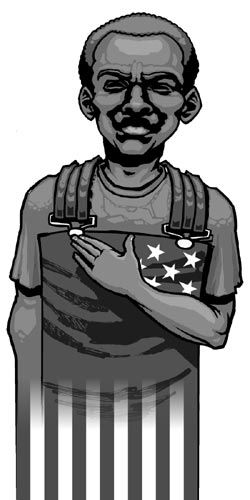Donate to IMPACT
Click below for info


• The White Escalator
• Quickies
(music reviews)
 • E-Mail Comments
• Archives
• Subscribe to IMPACT
• Where to Find
IMPACT
• Buy IMPACT T-Shirts
• Ordering Back Issues
• Home
|
 Climbing the White Escalator Climbing the White Escalator
by Betsy Leondar-Wright
art/Ralph W. Walters
"America is a meritocracy," my father always told me. The harder he worked, the more money he got: clear cause and effect. From individuals' prosperity or poverty, he believed he could determine their effort and talent. Therefore the poor black people in a nearby city clearly hadn't applied themselves.
My father had a legacy that he couldn't see, a legacy he only got because he is white. His ancestor, John Prescott, came from England in 1638. The Massachusetts Bay Colony granted him land in Central Massachusetts–something no people of color could have–and he built the first sawmill there. As far as I can tell, none of his descendants have ever been poor. Some of my ancestors moved west to Ohio in the 1800s, where they may have received land under one of the Homestead Acts, government programs that were closed to people of color.
My father is a World War II-era veteran, and he went to graduate school on the GI Bill. Most veterans of color were unable to access these education benefits. The few black colleges were swamped with applicants, and most other colleges accepted only white students. Job training programs in the South were also segregated and under local white control. African Americans represented one-third of the WWII vets in the South but received only one-twelfth of the job training slots.
My parents bought our first house with a Veterans Administration mortgage. The cheap subsidized mortgages of that era could not be used in mixed-race neighborhoods, or in inner cities. Because most banks issued only government-subsidized mortgages, most WWII veterans of color had to remain renters.
My father's parents received Social Security benefits, which spared my father from supporting them in their old age. This enabled him to pay for our college educations. Social Security initially excluded domestic and agricultural workers, which meant that most people of color did not qualify in the first decades of the program. The federal minimum wage law still excludes agricultural workers. The parents of today's middle-aged people of color typically had to support their own parents, and so couldn't save for their children's college tuition as easily as my parents saved for mine.
Of course, effort and talent do make a difference in climbing the staircase to prosperity. But for most white men, the staircase has been an escalator powered by public assistance. I saw this in my own family. My father had a relative who was unambitious, sweet but slow-thinking. He got a middle-management job where he stayed for decades, and he lived in the same small house until he retired with a pension. He was carried gently up the escalator, ending up lower than my dad, who put a lot of effort into climbing and so reached an upper management position. That was the range for college-educated WASP men of their generation: middle-management and small homes, or high-level jobs and big homes. They started in the middle of the staircase and were helped upward. Working-class white men may have started at the bottom, but in that era, they, too, had opportunities and assistance to climb.
Historically, for people of color, the escalator has been broken. Sometimes they have had to hike up a fast-moving down escalator. No matter how hard they worked, they rarely got the same rewards as white people. Their wages were lower, and many neighborhoods and schools were closed to them. In some eras and places, laws and violence kept them off the staircase to prosperity entirely.
Civil rights legislation has allowed people of color to step onto the escalator. But there's no GI Bill today. The more recent government programs open to people of color, such as welfare and Food Stamps, have been tiny compared to the vast assets conferred on whites by the Homestead Acts and the GI Bill. And these recent programs have only helped with immediate living expenses, not college, homeownership, or other assets that provide security for coming generations. People of color have recently become homeowners in greater numbers thanks mostly to their own savings, without the kind of substantial government assistance that white families got in the 1950s and 1960s.
Government boosts for white people were invisible to my father. He opposed government handouts as destroying incentives to strive, without considering the handouts his family had received. In truth, prosperity comes from a mix of individual effort and assistance from family and government. America won't be a meritocracy until the escalator rises at the same speed for everyone.
•
Betsy Leondar-Wright is the racial wealth divide communications director at United for a Fair Economy.
Email your feedback on this article to editor@impactpress.com.
|



 Climbing the White Escalator
Climbing the White Escalator